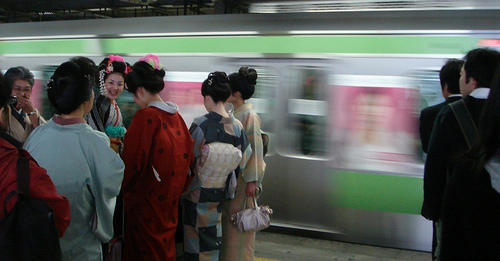Lesson 5 - Notes:
Subways and trains
(photo
by Christophe Richard used
under terms of Creative Commons license.)

1. Trains
(densha)
and subways
(chikatetsu)
are generally
the most
convenient and economical
transportation in and around
metropolitan areas of
Japan. Driving is
quite pleasant in the
countryside, but traffic
jams and extremely limited parking
can make driving
a nightmare in the
larger cities. Of course,
there are buses
(basu) running
in all
directions, but using
city buses can
be a little complicated. For instance,
each bus company
in Tokyo has
a different fare system.
Knowing where and
when to pay
can be problems,
and the solutions vary
according to the
bus line you
are riding
and your
need to transfer.
All things considered,
trains and subways are
wiser choices for
the casual traveler.
2. A
word of
caution,
however. WhiIe Japanese
trains and subways are
clean, quiet, and
punctual, they are
extremely crowded during rush
hours. Plan your
schedule to avoid
traveling during peak
commuter traffic.
3. Before
you take a
train, learn
something about how the
rail system operates. Get
maps, and plan
your route in advance.
At first, try
to go with
a friend who
already knows
the ropes.
4. The
first thing you
have to do
at the train
or subway
station is
to find out
the fare to
your destination. Fares are
shown on a
large route
map on the
wall near
the ticket
machines. Each
station or stop
appears as an
oval or square. On
the map, the
station where you
are is shown
in a solid
color or
by an arrow.
The fares to
other stations are
inside the ovals or
squares representing those
stops. Occasionally,
you will
see two fares.
The greater amount
is the adult
fare; the lesser, the
chiId's fare.
If you
know the direction
you are going
and the
number of
stops between your
present location and
your destination, you can
simply count stops
on the map.
Your fare
is the
amount shown in
the
oval
or square at
the final stop: your
destination.
5. The
next step is
purchasing a ticket.
Get a friend to
show you which
ticket machine (kenbai-ki) to
use, or ask
a
passerby. In most
cases, you drop
¥10 or ¥100
coins into a slot;
then, press the
button which shows
your fare. If
you
don't have enough
coins, you can
get change for
a ¥500 or a
¥IOOO note from
the change machine
(ryōgae-ki)
in larger
stations. At
smaller stations you
can get change
at a window.
6. Now
you go through
a wicket (kaisatsu-guchi), where an
attendant punches your
ticket. Be sure
not to throwaway the
punched ticket, because
you must turn
it in when
you pass
through the wicket
at
your destination.
7. Now
you have to
find the right
platform. You will often
find signs in
English, as
well as timetables
showing departure times. If
you have any
difficulty, ask a
passerby which way to
go for
trains
to your destination.
8. At
times, you may
want to find
out if you
are on the right
platform or train
or to find
out if the
next stop is your
destination. Asking a
fellow traveler is
quick and
painless. Doing this
will
not only put
your mind at
ease but will also
prove that your
Japanese really
works.
9. If
you
miss
your stop, get
off at the
next station,
cross the
platform, and get
on a train
going in
the direction
you came
from. By doing
this, you won't
have to pay
another fare.